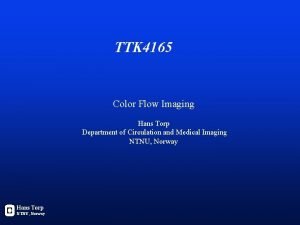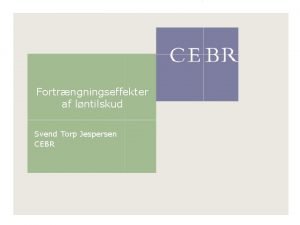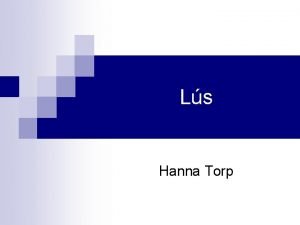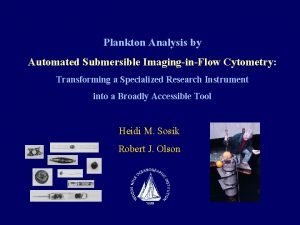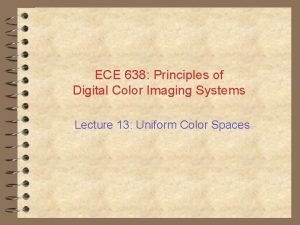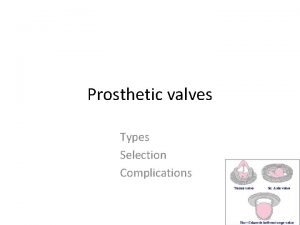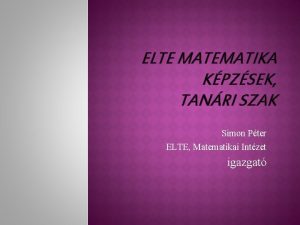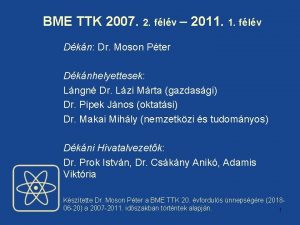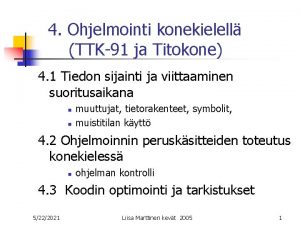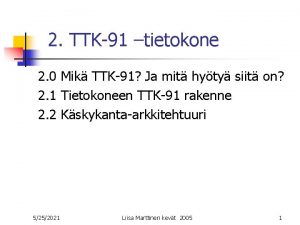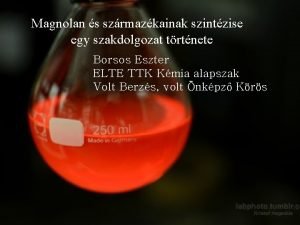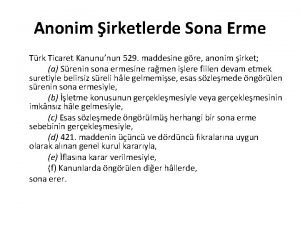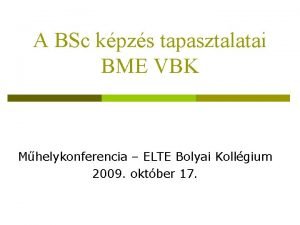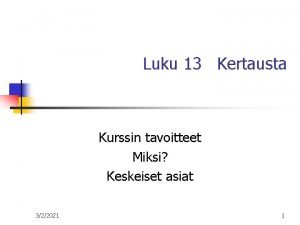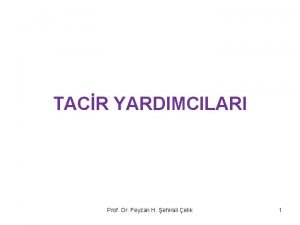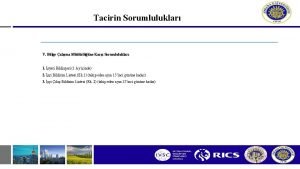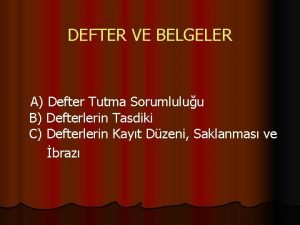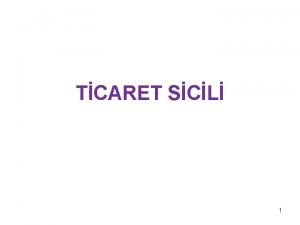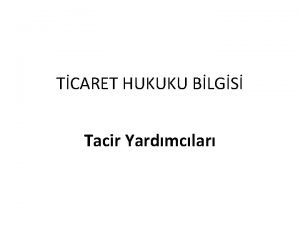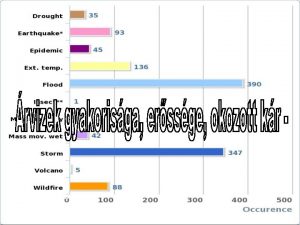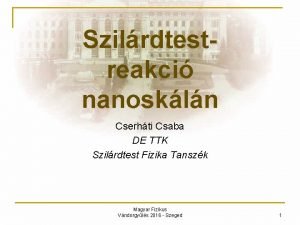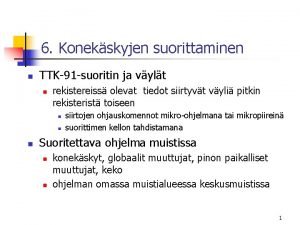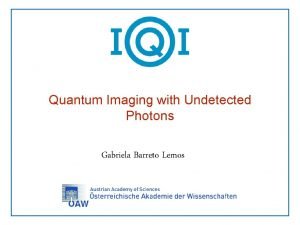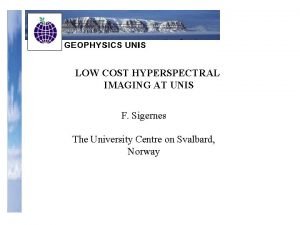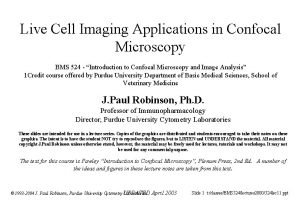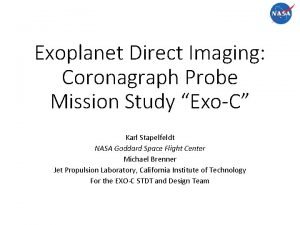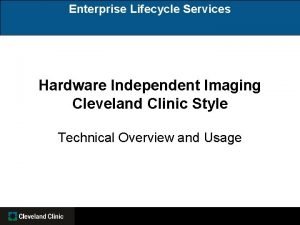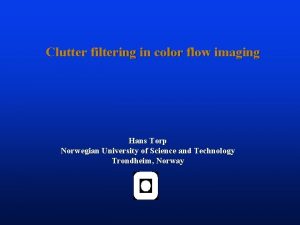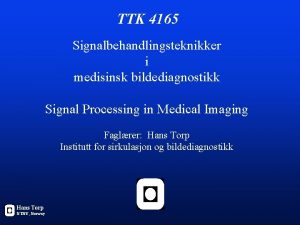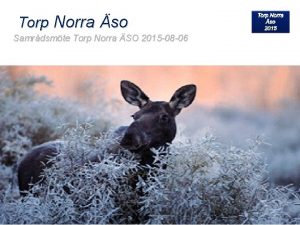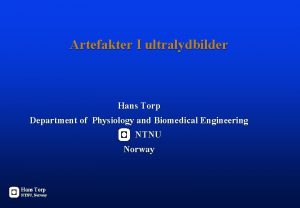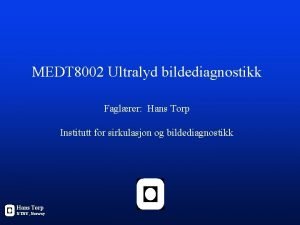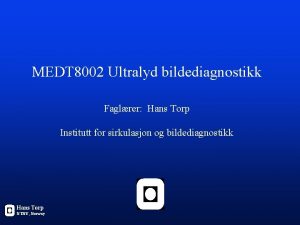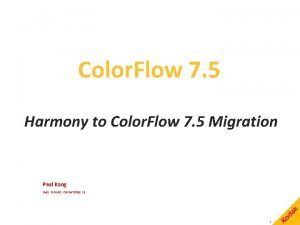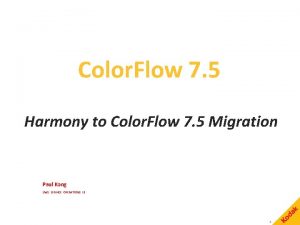TTK 4165 Color Flow Imaging Hans Torp Department
















![Doppler Signal Model 100 x = [x(1), …, x(N)]T • Zero mean complex random Doppler Signal Model 100 x = [x(1), …, x(N)]T • Zero mean complex random](https://slidetodoc.com/presentation_image_h/0d24300d64589347efd000bdff1f7c16/image-17.jpg)

![IIR filter with initialization Frequency response 0 Power [d. B] -20 Steady state Step IIR filter with initialization Frequency response 0 Power [d. B] -20 Steady state Step](https://slidetodoc.com/presentation_image_h/0d24300d64589347efd000bdff1f7c16/image-19.jpg)
![M -k = H(z) åbk z FIR Filters k =0 0 Power [d. B] M -k = H(z) åbk z FIR Filters k =0 0 Power [d. B]](https://slidetodoc.com/presentation_image_h/0d24300d64589347efd000bdff1f7c16/image-20.jpg)



















- Slides: 39

TTK 4165 Color Flow Imaging Hans Torp Department of Circulation and Medical Imaging NTNU, Norway Hans Torp NTNU, Norway

Color flow imaging • Estimator for velocity and velocity spread power, mean frequeny, bandwidth • Color mapping and visualization • • Clutter filtering Scanning strategies

Data acquistion in color flow imaging Beam k-1 Beam k+1 Number of pulses in each direction 3 – 15 Frame rate reduction compared to B-mode

2 D Color flow imaging 1. Limited information content in the signal, i. e. short observation time, low signal-to-noise ratio, and low Nyquist velocity limit. 2. Insufficient signal processing/display. Full spectrum analysis in each point of the sector is difficult to visualize.

Signal power: Mean frequency: Bandwidth:

Taylor expansion of exp-function

Autocorrelation method Power, meanfreq. , bandwidth derived from sample mean autocorrelation estimator

Autocorrelation method Scatter diagram of the autocorrelation estimator with lag m=1 for three different signals. To the right, a narrow band signal with center frequency ω1 =π/2 to the left, a slightly more broadband signal with ω1 =3π/2, and in the middle, high-pass filtered white noise.

Correlation angle ~Velocity Estimation error is minimum when correlation is maximum Hans Torp NTNU, Norway Correlation magnitude Matlab-demo: Acorr. Est. m

Estimator properties

Normalized Autocorrelation function (1) = R(1) / R(0)

Color mapping types Power Doppler (Angio) Color flow ”Variance map” Brightnes ~ signal power Hue ~ Velocity Hue & Brightnes ~ Velocity Green ~ signal bandwidth Hans Torp NTNU, Norway

Color scale for velocity and - spread Power Band width Aortic insufficiency Hans Torp NTNU, Norway

Color flow imaging Mitral valve blood flow Normal mitral valve Hans Torp NTNU, Norway Stenotic mitral valve

Autocorrelation method Sensitive to clutter noise Phase angle of R(1) substantially reduced due to low frequency clutter signal Clutter filter stopband much more critical than for spectral Doppler

Clutter filter in color flow imaging? Beam k-1 Beam k+1
![Doppler Signal Model 100 x x1 xNT Zero mean complex random Doppler Signal Model 100 x = [x(1), …, x(N)]T • Zero mean complex random](https://slidetodoc.com/presentation_image_h/0d24300d64589347efd000bdff1f7c16/image-17.jpg)
Doppler Signal Model 100 x = [x(1), …, x(N)]T • Zero mean complex random process • Three independent signal components: Signal = Clutter + White noise + Blood Doppler spectrum [d. B] • Signal vector for each sample volume: x=c+n+b • Typical clutter/signal level: 30 – 80 d. B • Clutter filter stopband suppression is critical! Hans Torp NTNU, Norway 80 60 Clutter Blood 40 20 0 -0. 6 -0. 4 -0. 2 0. 4 0. 6 Blood velocity [m/s]

Approaches to clutter filtering in color flow imaging • IIR-filter with initialization techniques • Short FIR filters • Regression filters
![IIR filter with initialization Frequency response 0 Power d B 20 Steady state Step IIR filter with initialization Frequency response 0 Power [d. B] -20 Steady state Step](https://slidetodoc.com/presentation_image_h/0d24300d64589347efd000bdff1f7c16/image-19.jpg)
IIR filter with initialization Frequency response 0 Power [d. B] -20 Steady state Step init. Discard first samples Projection init* -40 -60 -80 0 0. 1 0. 2 0. 3 0. 4 0. 5 Frequency Chebyshev order 4, N=10 *Chornoboy: Initialization for improving IIR filter response, IEEE Trans. Signal processing, 1992
![M k Hz åbk z FIR Filters k 0 0 Power d B M -k = H(z) åbk z FIR Filters k =0 0 Power [d. B]](https://slidetodoc.com/presentation_image_h/0d24300d64589347efd000bdff1f7c16/image-20.jpg)
M -k = H(z) åbk z FIR Filters k =0 0 Power [d. B] -20 Linear phase Minimum phase -40 • Discard the first M output samples, where M is equal to the filter order • Improved amplitude response when nonlinear phase is allowed -60 -80 0 0. 1 0. 2 0. 3 0. 4 0. 5 Frequency response, order M= 5, packet size N=10

Regression Filters b 3 Signal space Subtraction of the signal component contained in a K -dimensional clutter space: x x = [x(1), …, x(N)] y c y = x - c b 1 Clutter space Linear regression first proposed by Hooks & al. Ultrasonic imaging 1991 b 2

Why should clutter filters be linear? • No intermodulation between clutter and blood signal • Preservation of signal power from blood • Optimum detection (Neuman-Pearson test) includes a linear filter • Any linear filter can be performed by a matrix multiplication of the N - dimensional signal vector x Input vector x y = Ax Matrix A Output vector y * • This form includes all IIR filters with linear initialization, FIR filters, and regression filters

Frequency response Linear Filters y = Ax • Definition of frequency response function = power output for single frequency input signal 1 Ho(w) = Aew N [ iw 2 ; -p < w < p i (N-1)w ew = 1 e L e ] T Note 1. The output of the filter is not in general a single frequency signal (This is only the case for FIR-filters) Note 2. Frequency response only well defined for complex signals

FIR filter matrix structure FIR filter order M=5 Packet size N=10 Output samples: N-M= 5 Increasing filter order + Improved clutter rejection - Increased estimator variance Hans Torp NTNU, Norway

Regression Filters • Subtraction of the signal component contained in a K -dimensional clutter space: b 3 Signal space x y = x - c æ K Hö y = çI - åbi bi ÷x è i =1 ø A y c b 1 Clutter space Choise of basis function is crucial for filter performance b 2

Fourier basis functions i*2π*k*n/N bn(k)=1/sqrt(N)e n= 0, . . , N-1 are orthonormal, and equally distributed in frequency

Fourier Regression Filters Frequency response DFT 0 Set low frequency coefficients to zero Power [d. B] -20 -40 -60 Inverse DFT -80 0 0. 1 0. 2 0. 3 0. 4 Frequency N=10, clutter dim. =3 0. 5

Legendre polynom basis functions b 0 = b 1 = b 2 = b 3 = Gram-Schmidt process to obtain Orthonormal basis functions -> Legendre polynomials

Polynomial Regression Filters Frequency responses, N=10 b 0 = b 2 = -20 Power [d. B] b 1 = 0 -40 -60 b 3 = -80 0 0. 1 0. 2 0. 3 Frequency 0. 4 0. 5

Regression filter bias Magnitude and phase frequency response Polynomial regression filter packet size = 10, polynom order 3. Severe bias in bandwidth and mean freq. estimator below cutoff frequency.

How to image low velocity flow • Long observation time needed • Obtained by increased packet size or lower PRF • Beam interleaving permits lower prf without loss in framerate

Color flow scanning strategies time scanning direction B-mode scanning Mechanical scanning + No settling time clutter filter - low frame rate Electronic scanning Packet acquisition - Settling time clutter filter +flexible PRF without loss in frame rate Electronic scanning continuous acquisition + no settling time clutter filter + High frame rate - low PRF (=frame rate)

Color flow imaging with a mechanical probe v = W*FR v vr Image width Frame rate Sweep velocity W FR v= W*FR Example: Image width W = 5 cm Frame rate FR =20 fr/sec Angle with beam = 45 deg. Sweep velocity v= 1 m/s Virtual axial velocity: vr= v*cotan( ) vr > max normal blood flow velocities!

Color flow imaging with a mechanical probe v = W*FR Reflected wave does not hit the transducer Max Dopplershift 600 Hz ~ 0. 21 m/sec

Color flow imaging with a mechanical probe v = W*FR Signal from stationary scatterer N*Fr*t Power spectrum W= N*b Beamwidth (Rayleigh criterion): b Effective number of beams: N =W/b Frame Rate: FR Clutter signal bandwidth: Frequency components < fc removed Clutter filter cutoff frequency: fc > N*FR 2*N*FR

Minimum detectable Doppler shift Clutter filter cutoff frequency: fc > N*FR (transit time effect mechanical scan) Frame rate FR =1 Hz FR = 10 Hz FR=20 Hz N=30 30 Hz 300 Hz 600 Hz N=70 70 Hz 700 Hz 1400 Hz Width (# beams) Cardiac flow imaging: fo= 2 MHz, 15 mm aperture, beamwidth 3 mm 30 beams covers the left ventricle fc = 600 Hz ~ 0. 21 m/sec. lower velocity limit

Atlanta, GA april 1986 Vingmed, introduced CFM The first commercial colorflow imaging scanner with mechanical probe Horten, Norway september 2001 GE-Vingmed closed down production line for CFM after 15 years of continuous production

Minimum detectable Doppler shift Clutter filter cutoff frequency: fc > N*FR Frame rate FR =1 Hz FR = 10 Hz FR=20 Hz N=30 30 Hz 300 Hz 600 Hz N=70 70 Hz 700 Hz 1400 Hz Width (# beams) Periferal vessel imaging with fo= 10 MHz Mechanical scanning: fc = 1400 Hz ~ 108 mm/sec. Electronic scanning: fc = 30 Hz ~ 2. 3 mm/sec. Packet acquisition (P=10): Frame rate = 35 frames/sec Continuous acquisition: Frame rate = 350 frames/sec

Combining tissue and flow Continuous sweep acquisition + Brachial artery
 Hans torp
Hans torp Frc control system
Frc control system Svend torp andersen
Svend torp andersen Torp y sage 1998
Torp y sage 1998 Hanna torp
Hanna torp Imaging flow cytobot
Imaging flow cytobot Digital color imaging
Digital color imaging Ttk chitra valve
Ttk chitra valve Elte ik kriptográfia és biztonság
Elte ik kriptográfia és biztonság Bme ttk
Bme ttk Ttk-91
Ttk-91 Tilarekisteri
Tilarekisteri Pengertian ttk
Pengertian ttk Asisten tenaga kesehatan
Asisten tenaga kesehatan Elte ttk szakdolgozat
Elte ttk szakdolgozat Ttk 529
Ttk 529 Vbk moodle
Vbk moodle Bme ttk moodle
Bme ttk moodle Ttk-91
Ttk-91 Simsar nedir ttk
Simsar nedir ttk Ttk ya göre sorumluluklar
Ttk ya göre sorumluluklar 2.sınıf tacirin tutması gereken defterler
2.sınıf tacirin tutması gereken defterler Scl ticaret
Scl ticaret Pazarlamacı simsar dan ayıran özellikler
Pazarlamacı simsar dan ayıran özellikler Murat tacir serveti
Murat tacir serveti Elte ttk to
Elte ttk to Elte ttk tanulmányi ösztöndíj
Elte ttk tanulmányi ösztöndíj De ttk
De ttk Moodle pte ttk
Moodle pte ttk Elte megajánlott jegy
Elte megajánlott jegy Ttk-91
Ttk-91 Windows image acquisition
Windows image acquisition Gabriela barreto lemos
Gabriela barreto lemos Ohiohealth berger hospital mammography circleville
Ohiohealth berger hospital mammography circleville Affordable hyperspectral imaging
Affordable hyperspectral imaging Live cell imaging applications
Live cell imaging applications Curved mirrors worksheet
Curved mirrors worksheet Focused imaging learning
Focused imaging learning Direct imaging subsystem
Direct imaging subsystem Hardware independent imaging
Hardware independent imaging
